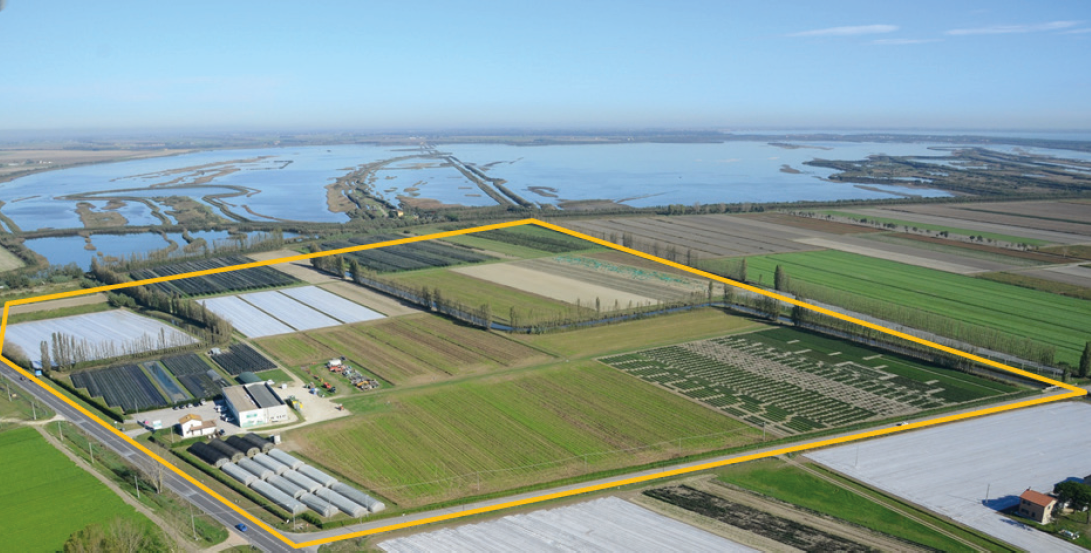CIV strawberry varieties: resistance since 1984

Nederlandstalige versie onderaan
When CIV started with breeding new strawberry varieties, natural resistance was one of the most important priorities for selection. In 37 years it is dr. Michelangelo Leis’ strategy. With succes, CIV-varieties are well known now: Clery as an early variety, Joly for direct sale, Murano and Cantus as everbearers… The new junebearers Sibilla and Lycia are also very interesting these times of restriction of crop protection products.
A good start…
For the development of new varieties, CIV makes year by year 60 to 80 new crosses, where each cross gives up to 1000 seedlings. At this way there are each year up to 80 000 seedlings! This high quantity is necessary to estimate all properties of the cross. All the seedlings grow on a trial site at the headquarter of CIV, in Italy. The location of the field is very important. Because of the location in the Po valley, between the Alps, Apenines and the Adriatic Sea, the climate is very humid in summer. Furthermore, the trial field isn’t desinfected for many many years. So, selections with a high sensitivity for diseases are directly eleminated.
Cooler climates
After the first selection in Italy, the remaining crosses go in an early stade to trial fields of Northern Europe in the United Kingdom. There, the plants will be confronted with a cooler climate. Selections which are doing good will be evaluated in sevaral research centers.
…is half the battle
By following this strategy consequently, CIV has a wide range of junebearers and everbearers with a high resistance against diseases, especially root diseases. Many growers don’t treat the plants against Phytophtora cactorum anymore during the season.
____________________________________________________________
Toen CIV in 1984 startte met de veredeling van nieuwe aardbeirassen kreeg de natuurlijke weerstand tegen ziekten de absolute prioriteit bij het selectiewerk. Al 37 jaar werkt dr. Michelangelo Leis aan deze strategie. Met succes, want de CIV rassen zijn nu wel gekend: Clery als vroeg ras, Joly voor directe verkoop, Murano en Cantus bij de doordragers…. De nieuwe junidragers Sibilla en Lycia krijgen nu ook veel belangstelling, in tijden waar het gebruik van gewasbeschermingsmiddelen steeds meer aan banden wordt gelegd.
Goed begonnen...
Voor de ontwikkeling van nieuwe rassen, maakt CIV jaarlijks 60 tot 80 nieuwe kruisingen, waarbij elk kruisingspaar tot 1000 zaailingen oplevert. Zo worden dus elk jaar 60000 tot 80000 nieuwe zaailingen gemaakt! Dit hoge aantal is nodig om de eigenschappen van een kruising ten volle te kunnen inschatten. Al die zaailingen komen op proefperceel te staan op de hoofdlocatie van CIV, in Italië. De locatie van dit selectieveld is van cruciaal belang. Door de ligging in de Po-vallei, ingesloten tussen de Alpen, de Apennijnen en de Adriatische Zee, is het klimaat er ’s zomers warm en heel vochtig. Bovendien werd het selectieveld al tientallen jaren niet meer ontsmet. Ziektegevoelige selecties worden er zo onmiddellijk en overbiddelijk geëlimineerd.
Koelere klimaten
Na een eerste selectie in Italië komen de resterende kruisingen in een zeer vroeg stadium naar de hoofdproefvelden voor Noord-Europa, in het Verenigd Koninkrijk. Zo worden ze ook blootgesteld aan de grillen van het kille, vochtige Engelse klimaat. Selecties die daar goed presteren, worden via meer gerichte rassenproeven in verschillende proefcentra in Europa verder geëvalueerd.
...is half gewonnen
Door deze strategie consequent te volgen beschikt CIV nu over een breed gamma junidragers en doordragers die weinig of niet gevoelig zijn voor ziekten, en wortelziekten in het bijzonder. Vele telers gieten de planten niet aan na het planten, en voeren ook geen behandelingen tegen Phytophtora cactorum meer uit tijdens de teelt.